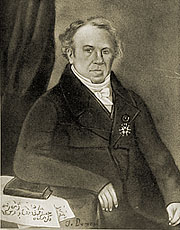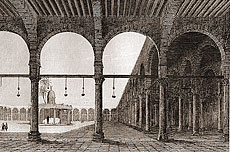Ancient Qur’ans from the J.-J. Marcel Collection. Fragments of Manuscripts
The printed Report of the Imperial Public Library for the year 1864 (St.Petersburg, 1865. Pp. 22-24) informed its readers that the Library had acquired 'the collection of ancient Kufic Qur'ans on parchment from Mrs Desnoyer, a heiress of the Arabist Marcel who was among the members of the French research expedition to Egypt, equipped by Bonapart'.Jan Joseph Marcel (1776-1854) stayed in Alexandria and Cairo from 1798 till 1801, having been appointed the head of the printing shop dispatched to Egypt together with Napoleon's military troops. Beside executing his direct duty of publishing newspapers for the French Army and leaflets for the Egyptians, he also practiced his Arabic and collected antiquities. After his return to Paris, Marcel became the head of the Republican printing house. Twelve years later, after Napoleon's downfall, he was discharged from public service and started to publish his own works.![]()
After Marcel's death, his heirs sold his private library. The Marcel library contained 3000 Oriental manuscripts, besides books. About a hundred of these manuscripts can be traced now in libraries in Paris, Munich, and Geneva. However, fragments of the 8th-11th century Qur'an manuscripts has been preserved as a single collection which is now stored in the National Library of Russia at Saint Petersburg. ![]()
The Holy Book of the Moslems is written in Arabic and contains 114 surahs (chapters), which are, in turn, subdivided into ayats (verses). Moslems believe that the Qur'an was revealed by a vision to the prophet Muhammad (571-632). Then it was passed on verbally and, eventually, was written down by Muhammad's followers in the 7th century. Finally, the text was unified during the reign of the third of the "Rightly Guided Caliphs" Uthman in the period between 644 and 656.
Mostly, only fragments (separate leaves or quires) of the earliest Qur'an's handwritten copies have survived. But they are priceless. Many of the large and famous museums and libraries can boast of possessing only a few leaves. Comparatively large collections are to be found only in several depositories of European and Middle Eastern cities, for example, in Istanbul (Turkey), Sanaa (Yemen), Tunis (Tunisia), Paris (France), Gotha (Germany). St. Petersburg counts among them. ![]()
In early manuscripts of Qur'an calligraphers usually did not specify the year of copying. This makes dating problematic. One of the fragments from the Marcel collection carries an record about a waqf (a religious endowment), which states that the manuscript was donated for charitable purposes (probably to the 'Amr ibn al-'As Mosque) by Abu Mansur [Musa] al-Fath b. Bugha al-Kabir (no. 6). It is known that this commander died in 877, therefore the manuscript fragment can be dated to the third quater of the 9th century (no. 5). ![]()
All the manuscripts in the collection are written on parchment except one, which is written on paper (Marcel 111). Parchment, being a specifically curried leather, can be very different in appearance: thick or very thin, sometimes even semi-transparent, brittle or flexible, but almost always hard. Its colour varies considerably from almost perfectly white to almost yellow. ![]()
The colour of the used ink ranges from almost black (probably carbon) (no. 1, 3, 5, 7, 8, 11) to brown (ferro-gallic ink) (no. 2, 12). On the hair side of a parchment sheet, the ink is usually better preserved than on the flesh side where it often crumbled away (no. 4, 12, 13). Red paint (no. 1) and gold (no. 10, 12, 13) is used sometimes for the Surah headings. ![]()
The Qur'ans are written in archaic scripts, including Hijazi (no. 2), Umayyad (no. 1), Kufic script of different types (no. 3, 4, 5, 7, 8, 10, 11, 12, 13, 14) and so-called "New style" font (no. 15). The Kufic script (derived from the city of Kufa founded by the Arabs in Mesopotamia) has given the name to all the early Qur'anic manuscripts which are called Kufic Qur'ans. The Kufic script can be very small and condensed (no. 3) as well as large and expanded (no. 5, 7, 8, 10, 11); some letters reach 6 cm in horizontal length.
The number of lines on pages differs from 25-27 (no. 1) to 5. The oldest manuscripts are more often in vertical format and have very narrow margins (no. 1, 2). Somewhere starting with the 9th century, the horizontal format prevails, although later it again gives its place to the vertical one (no. 15). In the most fine manuscripts, the text occupies an area only half as big as the area of the margins (no. 7, 8, 11, 12). One can imagine that such unpractical use of the parchment would not allow fitting the whole text of the Qur'an within a single volume. Usually, the Qur'an was divided into seven parts (called a sub') or thirty parts (called a juz'), which were bound separately. ![]()
Very often, Qur'anic manuscripts were decorated with the use of gold and different paints: red, blue, green. The most eye-catching ornaments precede Surahs as headpieces (no. 1). Usually, a medallion drawn in the shape of a branchy tree (no. 4) or a palmetto medallion (no. 10, 11, 12, 13) is joined with such headpiece on the outer margin. In some items, frontispieces, i.e. opening pages decorated with geometric designs, (no. 9) have survived (no. 9). Occasionally, other leaves of the manuscripts were decorated too (no. 5, 7). ![]()
Verse markers drawn between individual ayats and/or groups of verses also serve as decorations, varying from small modest rosettes (no. 16), to peer-shaped (no. 17, 21), or large round medallions. The latter often have the word "five", signifying the end of a group of five verses (no. 18, 19, 20). Others contain a multiple of ten, signifying the end of a group of ten verses (no. 22, 23, 24, 25, 26). Sometimes the words are replaced by a letter of the Arabic alphabet, which has a relevant numerical value (no. 27). ![]()
Due to the importance of J.J. Marcel's collection, the Max van Berchem Foundation (Switzerland) has given its support to a complex project involving conservation and preservation activities (microfilming, preservation of the most fragile leaves, etc.) as well as preparation of the electronic catalogue of the collection. V.V. Polosin (the Institute of Oriental Manuscripts of the Russian Academy of Sciences) and Francois Déroche (the Sorbonne, Paris) worked on this project together with the employees of the National Library of Russia in Saint Petersburg. At present the publication of the printed version of the illustrated catalogue of the Marcel collection of early Qur'ans is being prepared. ![]()
O. Vasilyeva
O. Yastrebova
Learn more…


